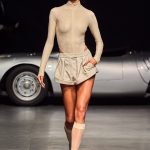
Elena Velez Spring 2026 Ready-to-Wear
As Elena Velez has often stated, she is “a ship captain’s daughter.” At the same time the designer is at the helm of her own ship, trying to chart new waters. “My mission with this brand is to democratize the American fashion narrative outside of the New Yorks and the LAs and to really see that there are other valuable perspectives to incorporate into how we think about this,” she said in a pre-show interview. What complicates this aim is that in showing on schedule, and selling to high-end stores, Velez is part of the system she is fighting against, or fighting from within.
And yet the blue collar uniform, from which the foundational elements of American fashion like jeans and tanks come from, is what Velez grew up with in the Midwest, so to some extent she can claim it. For spring the designer expanded on her denim offering, showing bumsters cut out of blue-and-white hickory stripe and a deconstructed dark-wash kind of frock coat dress with a Wonderbra-like effect. And although it’s difficult to see in the picture, the tank dress in look 11 was differentiated by delicate tucks. There were many wonderful garments on offer, but Velez wanted to go deeper, and address a moment in which, she said, there’s “this feeling of malaise where nobody has gotten what they want. Politically, socially, everyone seems to have buyer’s remorse.”
Velez turned to “literary legacies of bygone America” as an antidote. Having put Gone With the Wind back on the shelf, she turned to John Steinbeck, among others, explaining she was “looking at the Great Depression as an atmospheric parallel to the times we’re in right now, thinking about spiritual dust bowls and a search for some sort of truth or personal meaning.” What all this book talk suggests is that it might be possible to understand each of Velez’s collections as a chapter in her hero’s (or anti-hero’s) journey.
For spring, this seafarer changed her mode of locomotion. Packing a hobo bindle, she hopped aboard a train and, soot stained, imaginatively headed West. Her journey was inspired by real life crust punks—who, she explained, are “a transient punk subculture that rides trains and are kind of modern day drifters”—and the the work of Mike Brody, a photographer who documented these American roamers. In his portraits, the designer said she found a “bittersweet” reflection of the times.
Velez cannot be accused of perpetuating the upper middle class good taste and vanilla-ness that was seen in some of the New York collections. For spring (as always, really), she was chasing “the elusiveness of the American dream,” from an outsider’s view point—and even, this time, with unexpected charm. The idea with the show, Velez explained, was to evoke “a sense of voyage and journey and adventure, but also of playfulness.”
And so we were off on a wild ride with a cast of colorful characters, framed by the old-timey proscenium of The Box. The sense of travel was effectively accentuated with a patchwork quilt of a soundtrack that moved between decades and genres with the speed of a passing landscape viewed from the window of a speeding vehicle. Velez might have had circus carnies (see the first look) and tragic clowns in mind, but she sent tramps, prospectors, and saloon girls down the runway. The designer seemed to have the most fun playing with corsetry and a “prairie princess attitude,” but she explored new territory with a military green jacket with hook and eye closures, and several sailor-flap skirts, which were styled in various stages of disarray. Velez made use of many surface treatments, some of which made garments look dirty, like a button-front day dress that to this viewer recalled the mood of Dorothy Lange’s “Migrant Mother” photographs. At times Velez practiced a pick-and-mix romanticism of the past that glamorized or glossed over uncomfortable truths dealing with Westward migration and women’s limited autonomy—being a trad wife wasn’t an option. Yet there were pieces like button slit skirts, a puff-sleeved, basque front jacket, and a burgundy corset, that felt relevant.
Velez said she didn’t think it “appropriate to make feel good fashion for a moment that just doesn’t feel good,” but the prevailing mood wasn’t doom and gloom. When asked if there was light to be found in the darkness, the designer said the collection “is a portrait of people who are meeting the moment differently and unconventionally, and if that’s something people feel they can take away from this, then I suppose that that’s a helpful thing.” Yet the idea of a journey assumes freedom of movement. One of the takeaways here was to chart your own path.











